On January 25, 2013, a dolphin swam into Brooklyn, New York’s Gowanus Canal. Poor dolphin! Gowanus canal is a 1.8 mile long Superfund site—a toxic stew of pesticides, heavy metals and PCBs masquerading as “the waters of the United States” (to use the language of the Clean Water Act). A media circus ensued—TV stations set up camp beside the contaminated waters, news choppers hovered over the scene, reporters interviewed children worried about the dolphin’s fate. The dolphin’s struggles were streamed live on the internet. From all sides came the urging—do something! Save the dolphin from this environmental disaster into which it had unwittingly stumbled! Dolphin rescuers demurred, citing the risks to would-be rescuers from entering the toxic waters. A rescue decision was postponed until high tide in the hopes that the dolphin could free itself.
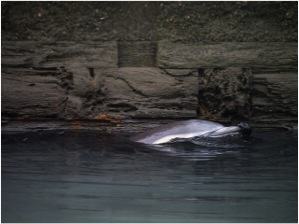
When the dolphin died under the glare of publicity, the polluted Gowanus Canal was suddenly a news story. Yet, the day before the dolphin arrived, the waters were just as polluted. And they remain so today, two months after the dolphin’s death. The cameras have moved on, the choppers hover over new disasters, while the Gowanus Canal remains a perilous trap—a grotesque stew posing a threat not only to marine mammals, but also to communities adjacent to the canal.
This ongoing danger typically gets little attention except from those most directly affected. Perhaps we are so habituated to the idea that economic “progress” demands the sacrifice our waterways that unsafe waters have been normalized. Yet, for a brief moment in January, the Gowanus dolphin pierced that apathy.
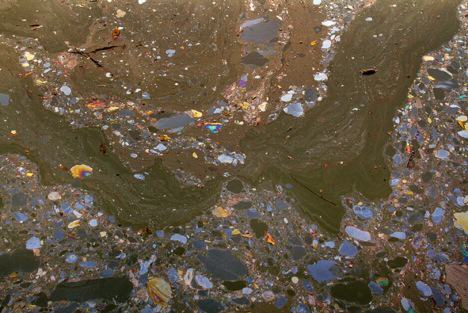
Even though a later autopsy showed the dolphin to be in such poor health that its death probably had little to do with the canal, the public narrative focused on the dolphin “struggle[ing] in the filthy gray canal.” And, indeed, it was quite an image—a beloved, charismatic marine mammal amidst the fetid sludge, surrounded by the litter and plastic detritus of modern urban life. The very fact of a dolphin in Gowanus Canal, let alone its death, captured the public imagination. I suggest it did so because the dolphin pierced the psychological barriers we use to separate urban places with their contaminated waters and lands from what we think of as “nature.” If the Gowanus dolphin could cross that seemingly stark divide, then perhaps the divide does not actually exist. Moreover, the dolphin’s journey brought home the true meaning of “interconnected waterways” at that term applies to waters regulated under the Clean Water. In addition to the more obvious physical interconnection between the ocean and the Gowanus Canal, the dolphin forced us to appreciate the temporal interconnections between the present Canal and the historical to which it had been put.
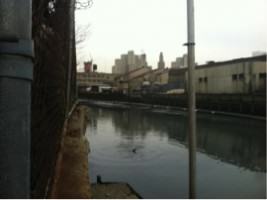
Contaminated waterways like the Gowanus canal are all too common in the United States and around the world. Nearly half of the lakes in America are too polluted for fishing or swimming. Of the more than 60,000 chemicals used in the United States, only 91 are regulated by the Safe Water Drinking Act. Toxic pollution spews into rivers, streams and bays, creating a staggering pollution load. As Juana Mariño Drews pointed out in her recent Nature of Cities blog post, “The current development model encourages the location of higher productivity activities in urban areas all over the world.” Polluted urban waterways like the Gowanus Canal and the nearby, similarly-contaminated Newtown Creek are predictable byproducts of that phenomenon.
Indeed, the Gowanus Canal’s history marks the trajectory of a changing relationship between people and their environment in New York. Early Dutch settlers found the Carnarsee Indians living and farming along the Gowanus creek’s rich shores. Indeed, the name Gowanus derives from “Gowanes,” the name of a tribal leader. The Dutch settlers soon forced out the Native inhabitants, and began catching vast quantities of fish and raising beds of oysters for sale to European markets. Overexploitation and pollution from a growing shore-side settlement began to cut into what had been abundant fish populations. Sewage contamination skyrocketed.
In 1849 the New York State Legislature authorized the construction of the Gowanus Canal, a dead-end channel connecting the Port of New York with the Gowanus Bay, and ultimately the Atlantic Ocean. The Canal soon became one of the nation’s busiest industrial waterways. Among the industrial facilities concentrated along its banks were oil refineries, manufactured gas plants, paper mills, tanneries and chemical plants. These facilities discharged large quantities of industrial waste directly into the Canal. Industrial pollutants, combined with storm-water runoff and raw sewage (the Canal served as an open sewer in the 1860s), turned the canal into a fetid, stagnant pool.
By the middle of the 20th century, truck transportation (including along the Gowanus expressway) largely replaced shipping through the canal. The Army Corps stopped dredging and sediment built up in the canal. New York had entered a period of industrial decline, and by the late 1970s, half the properties along the Gowanus were abandoned and derelict. Economic activity may have moved on, but the legacy of prior industrial activity remained. High levels of toxic and hazardous substances turned the Canal into a “Lavender Lake”—an oily, smelly, polluted mess.
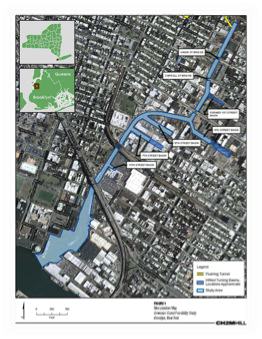
Several residential neighborhoods border the Canal, including Gowanus, Park Slope, Cobble Hill, Carroll Gardens and Red Hook. Thousands of people live within one block of the canal. While the waterfront properties directly abutting the canal are primarily commercial and industrial, the City began rezoning these parcels to high density residential use, apparently on the principle that New York can gentrify anything. A major developer recently proposed a 700 unit residential development, and construction of a Whole Foods along the Canal is nearly complete.
Yet, no glossy development brochure can change the reality just living near the Canal puts nearby residents in jeopardy. Recent testing show detected than a dozen contaminants in the Canal. Among the most dangerous were carcinogenic polycyclic aromatic hydrocarbons (PAHs), polychlorinated biphenyls (PCBs) and toxic heavy metals, including mercury, lead and copper. Additional contaminants continue to migrate into the canal from the adjacent abandoned industrial sites.
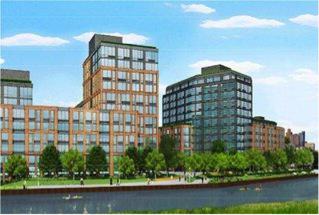
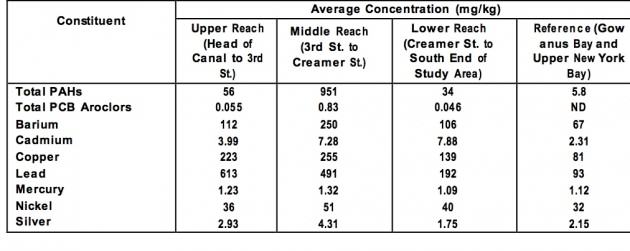
Upper, Middle, and Lower Canal. Table from EPA Feasibility Study.
During routine storm events, raw sewage flows into the canal from 10 combined sewer overflow (CSO) outlets and three stormwater outfalls dump 355 million gallons of sewage and stormwater into the Canal.
Hurricane Sandy brought a new level of risk. Storm surge caused the Canal to overflow its banks—sending contaminated waters into the nearby neighborhoods, including sites currently proposed for high-density residential development. New York City Councilmember Brad Lunder, advised his Gowanus Canal area constituents: “do not touch standing water in the area, or any sediment or debris left by Gowanus flood-waters.” The Mayor’s Office advised residents to “wash their hands and practice proper hygiene if they come into contact with the canal’s water or sediments.”
Undoubtedly good advice, these messages to avoid the contaminated floodwaters and sediments were of little use to residents facing flooding (sometimes of well over 6 feet) in their houses.
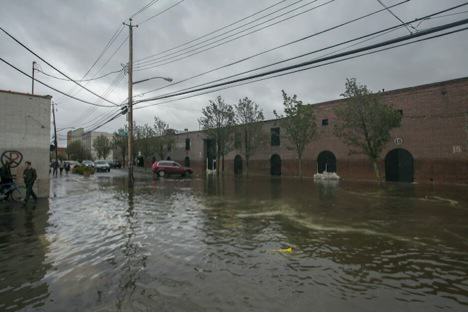
If the poor dolphin had no idea what it was getting into, government officials most assuredly did. Responding to what it identified as “a clear threat to human health and the environment,” the United States Environmental Protection Agency (EPA) added the Gowanus canal to the National Priorities List (NPL) in 2010, calling the canal “one of the nation’s most extensively contaminated water bodies.” The NPL was created by the 1980 Comprehensive Environmental Response, Compensation and Liability Act (CERCLA), popularly known as the Superfund. Once EPA listed the Gowanus Canal, cleaning up the canal became a “national priority” and under 42 U.S.C. §121(b)(1) EPA must devise a remedial plan that will be “protective of human health and the environment.” To that end, EPA conducted more extensive investigations of the contamination at the site. In 2011, EPA confirmed that contamination of the Gowanus Canal “is widespread and may threaten people’s health, particularly if they eat fish or crabs from the canal or have repeated contact with the canal water or sediment.”
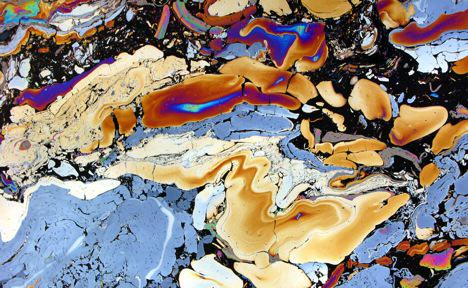
This past December, EPA took a first major step toward cleaning up the Gowanus Canal by releasing a Feasibility Plan for the Gowanus Canal. The public comment period on this plan runs until April 27, 2013. Loaded as it is with PCBs, coal tar wastes, heavy metals and volatile organics, EPA estimates that recreational users of the Canal would be exposed to a carcinogenic risk of 1 x 10,-3 meaning that one out of every thousand people using the canal for recreational purposes would develop cancer from those activities. The Agency pegged the overall cancer risk for residents living near the Canal at 3 x 10-4—meaning three extra cancer cases for every 10,000 residents exposed to the site’s contaminants—a level well about the 1 x 10-6 (one in a million) level EPA generally considers acceptable. Thus EPA concluded that the Canal posed unacceptable risk levels for surface water/sediment contact and fish consumption.
Testing also shows that fish and shellfish in the canal pose a danger to those who eat it, with Mercury and PCB contamination posing the highest risks. A New York State Department of Health fish advisory covers the entire Gowanus Canal, and signs posted along the canal warn of the dangers of eating fish from the Canal. Yet, subsistence fishing, by environmental justice communities surrounding the canal continues.
Congress passed the 1972 Clean Water Act “to restore and maintain the chemical, physical, and biological integrity of the Nation’s waters.” The Act set a legislative goal of “fishable, swimmable waters” by 1983. For many rivers, lakes and streams, this law has made a difference. Yet, thirty years later, the Gowanus Canal, like Newtown Creek, the Bronx River, the East River and many other urban waterways throughout New York and around the country have been left behind. The Gowanus Canal is neither fishable nor swimmable. Its sediment is toxic to benthic organisms, and its waters pose a risk to a wide range of reptiles, amphibians and waterfowl. Fish from the canal are unsafe for human consumption and just touching the water poses health risks. The Canal thus utterly fails to meet the key goals of Section 101 of the Act.
Multiple community groups have advocated for years to clean up the Canal. Frustrated at the slow pace of clean up, in the late 1990’s citizens began taking matters into their own hands. For more than a decade, the Gowanus Dredgers Canoe Club has run a public education campaign that includes free canoe tours of the Canal and shoreline cleanup initiatives.
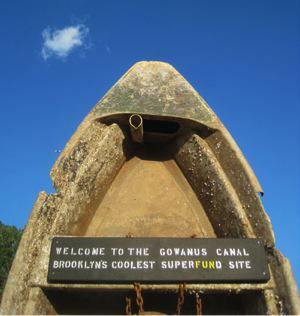
The most recent iteration of community action is a citizen science project launched in December 2012 by Brooklyn Atlantis, a collection of scientists associated with the Polytech Institute of New York University. The group developed a solar-powered, remote-controlled aquabot to explore the canal. As part of this project, the aquabot takes readings every few seconds of the Canal’s water quality—including pH, oxygen levels, and other measures of the waterway’s health. That data, along with photos from above and beneath the water, is then uploaded to the project’s website. The public is invited to help tag items captured in the photos in order to develop an aggregate picture of the canal’s conditions across time.
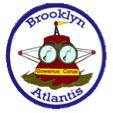 Cleaning up the Gowanus Canal is expected to take more than a decade, and will cost approximately $500 million. A separate NY State-managed cleanup is focusing on contaminated land sites along the canal, including three former manufactured gas plants. EPA clearly stated that it does not expect the cleanup to mean that it will be safe to eat fish from the Canal. Indeed, $500 million and 10 years of effort will not make the Gowanus Canal safe for drinking, fishing or swimming. It will certainly make the Canal less of a health threat for nearby residents, but the Canal will continue to pose a danger for wayward dolphins.
Cleaning up the Gowanus Canal is expected to take more than a decade, and will cost approximately $500 million. A separate NY State-managed cleanup is focusing on contaminated land sites along the canal, including three former manufactured gas plants. EPA clearly stated that it does not expect the cleanup to mean that it will be safe to eat fish from the Canal. Indeed, $500 million and 10 years of effort will not make the Gowanus Canal safe for drinking, fishing or swimming. It will certainly make the Canal less of a health threat for nearby residents, but the Canal will continue to pose a danger for wayward dolphins.
So, perhaps the clearest lesson the Gowanus dolphin taught is that we live (and die) connected to the legacies of past development choices. Our grandchildren, and the marine mammals with whom we hope they still share the earth, will bear the consequences of choices we make today about greenhouse gas emissions, about toxic substances, about pollution more generally. Unless we change things, and soon, it is likely that they will inherit a Gowanus Canal that is still not safe for dolphins (and children).
Rebecca Bratspies
New York City

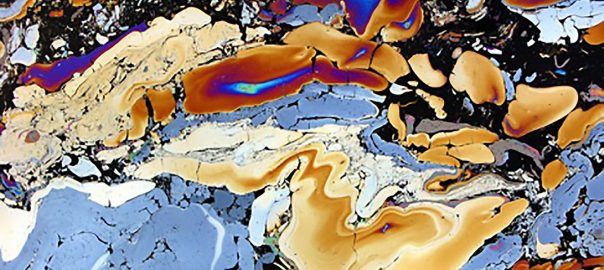


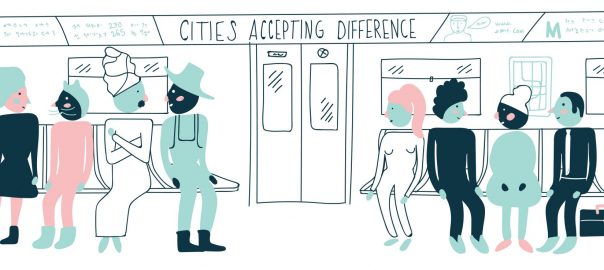
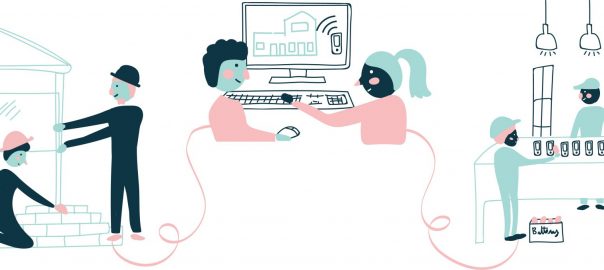
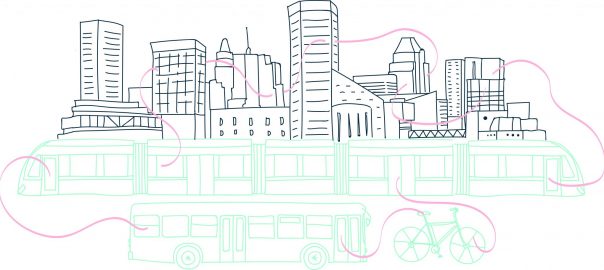
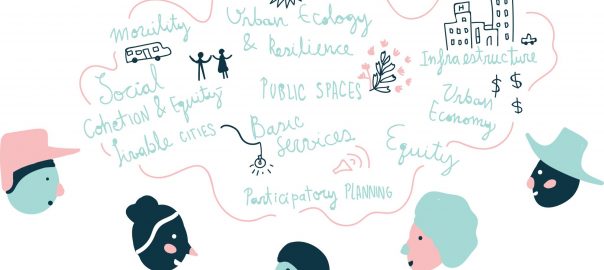
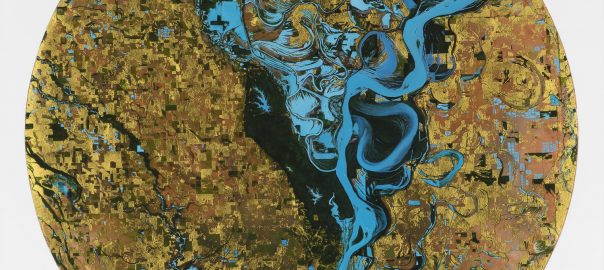

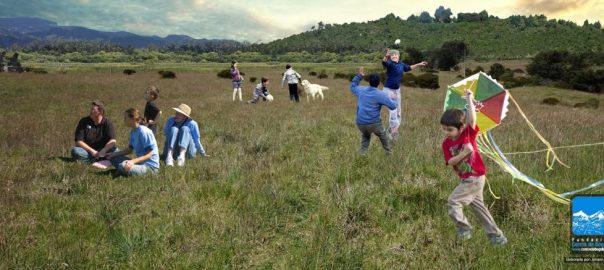

Add a Comment
Join our conversation